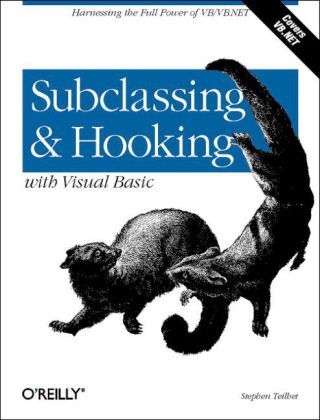Read more
Subclassing & Hooking with Visual Basic offers developers a unique way to customize Windows behavior.
Windows is a message-based system. Every action you request creates one or more messages to carry out the action. These messages are passed between objects and carry with them information that gives the recipient more detail on how to interpret and act upon the message.
With Subclassing and the Windows hooking mechanism ("hooks"), you can manipulate, modify, or even discard messages bound for other objects within the operating system, in the process changing the way the system behaves. What kinds of results can you achieve using the power of subclassing and hooking?
Here are just a few of the possibilities: Determine when a window is being activated or deactivated and respond to this change - Display descriptions of menu items as the mouse moves across them - Disallow a user to move or resize a window - Determine where the mouse cursor is and respond accordingly - Determine when the display resolution has been changed - Monitor the system for a low system resource condition - Modify or disallow keystrokes sent to a window or a control - Create an automated testing application - Determine when an application is idle.
Along with this power comes responsibility; Windows is very unforgiving if subclassing and hooking are used incorrectly. Subclassing & Hooking with Visual Basic demonstrates the various techniques for intercepting messages bound for one or more windows or controls: the intercepted message can be left in its original state or modified; afterwards, the message can be sent to its original destination or discarded.
For both VB 6 and VB.NET developers, Subclassing & Hooking with Visual Basic opens up a wealth of possibilities that ordinarily would be completely unavailable, or at least not easy to implement.
List of contents
Preface
Introducing Subclassing and Hooking
Chapter 1: Introduction
Chapter 2: Windows System-Specific Information
Chapter 3: The Basics of Subclassing and Hooks
Subclassing and Superclassing
Chapter 4: Subclassing
Chapter 5: Subclassing the Windows Common Dialog Boxes
Chapter 6: ActiveX Controls and Subclassing
Chapter 7: Superclassing
Chapter 8: Debugging Techniques for Subclassing
Hooking
Chapter 9: WH_CALLWNDPROC
Chapter 10: WH_CALLWNDPROCRET
Chapter 11: WH_GETMESSAGE
Chapter 12: WH_KEYBOARD and WH_KEYBOARD_LL
Chapter 13: WH_MOUSE and WH_MOUSE_LL
Chapter 14: WH_FOREGROUNDIDLE
Chapter 15: WH_MSGFILTER
Chapter 16: WH_SYSMSGFILTER
Chapter 17: WH_SHELL
Chapter 18: WH_CBT
Chapter 19: WH_JOURNALRECORD
Chapter 20: WH_JOURNALPLAYBACK
Chapter 21: WH_DEBUG
The .NET Platform
Chapter 22: Subclassing .NET WinForms
Chapter 23: Implementing Hooks in VB.NET
Appendixes
Messages
API Functions
Structures and Constants
Colophon
About the author
Stephen Teilhet hat einen Abschluss als Elektroingenieur erworben, begann aber bald darauf, Software für die Windows-Plattform zu schreiben. In den letzten acht Jahren hat er für verschiedene Consulting-Unternehmen an einer ganzen Reihe von Projekten gearbeitet und sich auf Visual Basic, Visual C++, MTS, COM, MSMQ und SQL Server spezialisiert. Zur Zeit arbeitet Stephen für Compuware Numega Labs in Nashua, New Hampshire, wo er an vielen preisgekrönten Produkten einschließlich DevPartner CodeReview und zuletzt DevPartner SecurityChecker mitgewirkt hat.
Summary
Subclassing and the Windows hooking mechanism ("hooks") allow developers to manipulate, modify, or even discard messages bound for other objects within the operating system. This book provides several possibilities to the Visual Basic developer.

